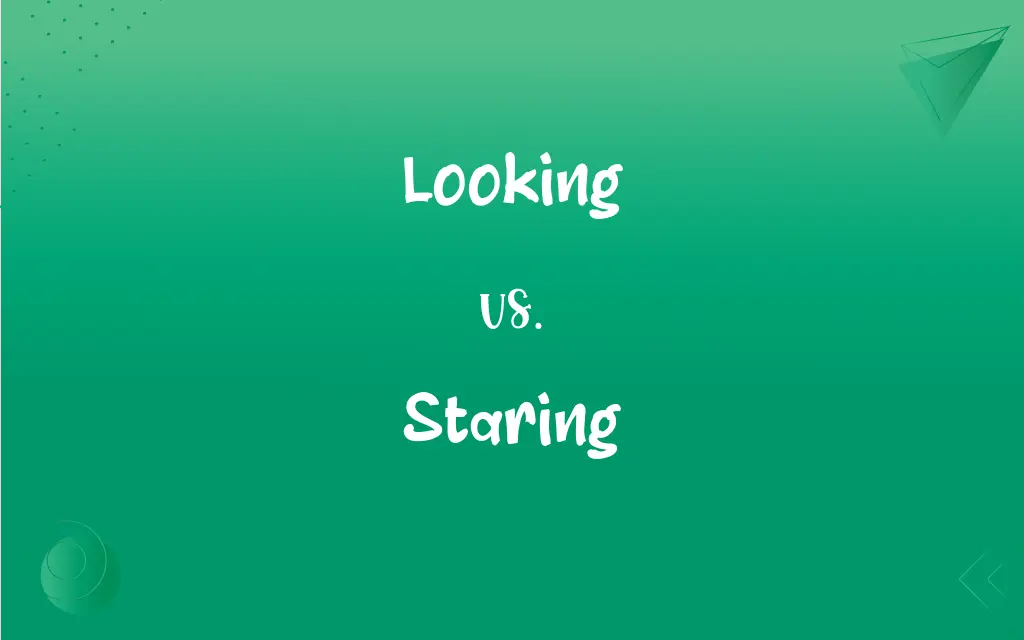Looking vs. Staring: What's the Difference?
Edited by Aimie Carlson || By Janet White || Published on December 19, 2023
Looking is a brief or casual act of directing one's gaze, whereas staring involves a fixed, intense, and prolonged gaze.

Key Differences
Looking refers to the act of directing the eyes towards something, often in a casual or brief manner. Staring, on the other hand, is characterized by a prolonged and intense gaze, often perceived as more invasive or intense than merely looking.
When someone is looking, it generally implies a voluntary and often fleeting act of seeing. In contrast, staring is often associated with a deeper level of interest, curiosity, or scrutiny, and can sometimes be considered rude or aggressive.
Looking can be a neutral or polite action, used in everyday visual interactions. Staring, however, often conveys a stronger emotion or intent, such as surprise, disbelief, admiration, or hostility.
In social contexts, looking is a common, non-intrusive behavior. Staring, however, can make people feel uncomfortable or self-conscious, as it may be perceived as staring down or gawking.
The difference also lies in the duration and intensity; looking is usually brief and light, whereas staring is longer and more focused or fixed.
ADVERTISEMENT
Comparison Chart
Duration
Brief, transient
Prolonged, continuous
Intensity
Generally mild and casual
Intense, focused
Social Perception
Neutral, socially acceptable
Often seen as rude or aggressive
Emotional Connotation
Indicative of casual interest or glance
Implies deeper interest or scrutiny
Frequency in Social Interactions
Common and frequent in daily life
Less frequent, can cause discomfort
ADVERTISEMENT
Looking and Staring Definitions
Looking
Directing the eyes toward something.
She was looking at the painting.
Staring
Fixing the eyes on someone or something for a long time.
He was staring at the horizon.
Looking
Trying to find something by sight.
She kept looking for her lost keys.
Staring
Looking fixedly, often considered impolite.
Staring at strangers is generally frowned upon.
Looking
Viewing or regarding in a certain way.
They were looking at various options for the project.
Staring
Gazing with prolonged focus.
She kept staring at the mysterious painting.
Looking
Seeming or giving the impression.
The sky is looking cloudy today.
Staring
Looking without blinking.
The cat was staring unblinkingly at the toy.
Looking
Glancing or watching briefly.
He spent the morning looking out the window.
Staring
Showing surprise, disbelief, or other emotions through one’s gaze.
They were staring in shock at the news.
Looking
To employ one's sight, especially in a given direction or on a given object
Looking out the window.
Looked at the floor.
Staring
To look directly, fixedly, or vacantly, often with a wide-eyed gaze.
Staring
To look at directly and fixedly
Stared him in the eyes.
FAQs
How is looking used in communication?
Looking is a fundamental part of non-verbal communication, often indicating interest or attention.
Does staring always convey negative emotions?
Not always, it can also express positive emotions like admiration.
What might prolonged staring indicate?
It can indicate deep interest, curiosity, surprise, or sometimes hostility.
Can staring be a form of non-verbal aggression?
Yes, in some contexts, staring can be perceived as aggressive or confrontational.
How can staring affect social dynamics?
Staring can create tension or discomfort, impacting social interactions negatively.
Is staring ever a medical concern?
In some cases, excessive staring can be related to neurological or psychological conditions.
Does staring have different meanings in different contexts?
Yes, context greatly influences how staring is perceived and interpreted.
What does looking entail?
Looking involves directing your gaze towards something briefly and casually.
Can looking be involuntary?
Yes, looking can be both a voluntary and involuntary action.
Is staring considered rude?
Often, yes, as it implies a fixed, intense gaze that can make others uncomfortable.
How do children learn about looking and staring?
Children learn the social norms of looking and staring through observation and socialization.
How does the digital age affect looking and staring?
Digital communication has altered the dynamics of looking, with less direct eye contact.
Is looking important for social interaction?
Yes, it plays a crucial role in showing engagement and attention.
Is looking away significant in communication?
Yes, looking away can signal disinterest, discomfort, or distraction.
Are there cultural differences in looking behaviors?
Yes, norms for eye contact and looking vary widely across cultures.
Can looking habits change with age?
Yes, factors like confidence and social awareness can change how individuals engage in looking.
Do animals understand human looking behaviors?
Some animals are sensitive to human gaze and can interpret looking or staring behaviors.
Can looking be a form of appreciation?
Certainly, looking at art or nature often expresses appreciation.
Is avoiding eye contact the same as not looking?
Not exactly; avoiding eye contact is often a deliberate choice, whereas not looking may be more passive.
Can staring be a form of flirtation?
Yes, in some contexts, staring can be flirtatious, though it's important to be aware of social cues.
About Author
Written by
Janet WhiteJanet White has been an esteemed writer and blogger for Difference Wiki. Holding a Master's degree in Science and Medical Journalism from the prestigious Boston University, she has consistently demonstrated her expertise and passion for her field. When she's not immersed in her work, Janet relishes her time exercising, delving into a good book, and cherishing moments with friends and family.
Edited by
Aimie CarlsonAimie Carlson, holding a master's degree in English literature, is a fervent English language enthusiast. She lends her writing talents to Difference Wiki, a prominent website that specializes in comparisons, offering readers insightful analyses that both captivate and inform.







































































